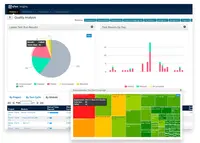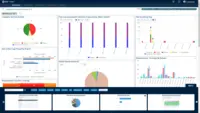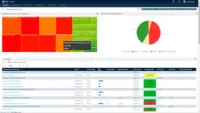Starting at $1,200 per year per user
View PricingOverview
What is Tricentis qTest?
Tricentis qTest (formerly QASymphony) provides enterprise-level agile testing tools giving businesses visibility and control needed to ensure application quality in fast-paced development environments. Tricentis and QASymphony merged in summer 2018.
Recent Reviews
How Tricentis qTest Differs From Its Competitors
Awards
Products that are considered exceptional by their customers based on a variety of criteria win TrustRadius awards. Learn more about the types of TrustRadius awards to make the best purchase decision. More about TrustRadius Awards
Popular Features
- Centralized test management (25)8.888%
- Test execution reporting (25)8.585%
- Defect management (21)7.777%
- Manage test hosts and schedules (22)7.777%
Reviewer Pros & Cons
Pricing
Entry-level set up fee?
- Setup fee optional
For the latest information on pricing, visithttps://www.tricentis.com/products/unif…
Offerings
- Free Trial
- Free/Freemium Version
- Premium Consulting/Integration Services
Starting price (does not include set up fee)
- $1,200 per year per user
Product Demos
qTest: Project Field Settings
YouTube
Features
Return to navigation
Product Details
- About
- Integrations
- Competitors
- Tech Details
- Downloadables
- FAQs
What is Tricentis qTest?
Tricentis qTest is a scalable test management solution that integrates with planning, testing, and DevOps tools, like Jira, Selenium, and Jenkins, giving teams a complete, unified view of testing throughout the software development cycle. It supports Agile, waterfall, or any hybrid methodology, allowing QA and development teams to approach testing strategically and collaboratively, and to release higher quality software faster.
Tricentis qTest Features
Test Management Features
- Supported: Centralized test management
- Supported: Manage test hosts and schedules
- Supported: Test execution reporting
- Supported: Defect management
Additional Features
- Supported: Jira integration: Event-driven sync with Agile planning tools for up-to-date traceability
Tricentis qTest Screenshots
Tricentis qTest Videos
Tricentis qTest Integrations
- Jira Software
- Jenkins
- Selenium
- Bamboo
- GitHub
- Tricentis Tosca
- Tricentis NeoLoad
- TestNG
- JUnit
- Azure Pipelines
- Azure Boards
- Tricentis Vera
Tricentis qTest Competitors
Tricentis qTest Technical Details
| Deployment Types | On-premise, Software as a Service (SaaS), Cloud, or Web-Based |
|---|---|
| Operating Systems | Windows, Linux |
| Mobile Application | No |
| Supported Countries | Global |
| Supported Languages | English |
Tricentis qTest Downloadables
- Tricentis qTest: Unified test management and orchestration
- Tricentis qTest Manager + Jira Software
- qTest Launch: Test Automation Management
- qTest Insights: Robust Analytics and Reporting for Agile Dev Testing
- qTest Explorer: Exploratory Testing for Agile Teams
- qTest Scenario: Enterprise BDD for Jira Software
Frequently Asked Questions
Tricentis qTest (formerly QASymphony) provides enterprise-level agile testing tools giving businesses visibility and control needed to ensure application quality in fast-paced development environments. Tricentis and QASymphony merged in summer 2018.
Tricentis qTest starts at $1200.
OpenText ALM/Quality Center, QMetry Test Management, and Zephyr Enterprise are common alternatives for Tricentis qTest.
Reviewers rate Centralized test management highest, with a score of 8.8.
The most common users of Tricentis qTest are from Enterprises (1,001+ employees).











